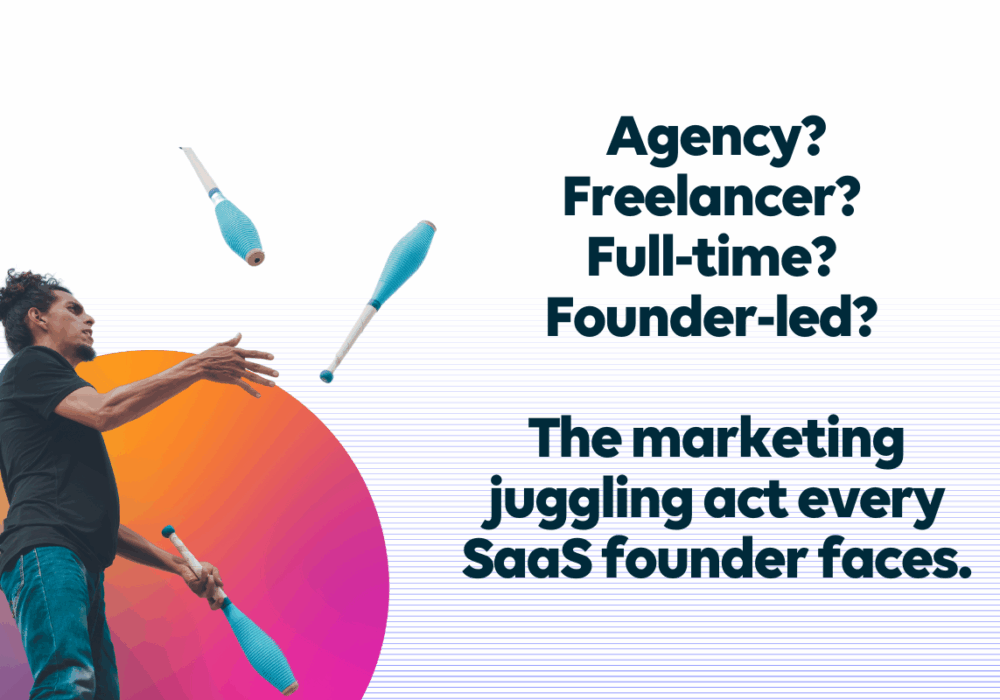How to Upcycle Content to Reach a Wider B2B Audience
3rd October 2022

Content marketing is still king, with 82% of marketers actively using it to engage with audiences, attract leads, and persuade people to make a purchase. This is no different for B2B SaaS marketers, who rely on helpful, educational content to tap into their audiences’ pain points and place themselves as thought leaders.
However, content can easily fall into a rut, with marketers creating the same type of content for the same audiences again and again. Once you hit “publish” on a new blog or video, it’s all too easy to move straight on to the next one without questioning where you can add value.
Instead, consider making your existing content work harder for you by repurposing it. This process involves reworking blogs, articles and videos into new forms for new channels. Repurposing or upcycling content allows you to expand your reach and appeal to new demographics, all while saving time.
Note that we use the term upcycling here: repurposing content shouldn’t be a matter of simply reposting old content or promoting your posts across channels. It needs to be actively and creatively worked on to give it new life and new dimensionality.
Done right, upcycling content can be a powerful part of your SaaS marketing strategy. In fact, 46% of marketers believe that repurposing content yields better results than creating brand new content. Read on to discover how to give your content new life and your messaging new audiences.
How upcycling content increases reach
Creatively repurposing content can help you scale your amount of content and your audience reach. In a world where social and search algorithms look to breadth as well as depth of content when it comes to your authority, you can shine by showing a range of content types without skimping on the substance.
For example, a well-written blog post may reach a section of your intended audience. These visitors may have found your blog via search results or clicked through from an email or social post. However, if the content of your blog post can be reworked as an eBook or a YouTube how-to video, your presence is tripled, with three different access points for audiences to discover your content.
Much of this comes down to personal preference: some potential customers prefer to read articles to stay on top of industry news, while others like to watch videos or listen to podcasts. By providing the same content in multiple formats, you give people the opportunity to consume it in a way that works for them, ensuring greater engagement across the board.
Repurposing content also allows you to publish content more frequently, which creates more opportunities for you to actively engage with your audience. Instead of promoting one blog post each week on your socials, you can point followers to a steady stream of articles, infographics, podcast episodes and videos, all thematically linked.
Upcycled content can give your SEO a boost as well. Well-repurposed content centred around the same targeted keywords demonstrates to search engines that you are a source of authority on that topic. With a library of valuable multimedia resources, your site will be exactly the sort of relevant domain that search engines want to recommend.
How to upcycle a blog post
Most content marketers start with blogs. Blogs are an easy way to position yourself as an expert in your field, while increasing the content on your site to boost dwell time. However, in a social media influenced world where we’re used to short videos, snappy pull quotes and 280 character tweets, not everyone is going to commit to reading the full post.
Using your blog post as a basis for content in different formats will ensure your brand appeals to a more diverse range of audience personas and consumption preferences, and meets customers where they are across more channels.
Video
YouTube is the number one platform for marketers to build communities on as of 2022 – and with TikTok creating a storm amongst younger consumers, video is on the up and up.
Branch out from blog posts by creating short covering snippets of content from your blog. These could take the form of how-to demonstrations or creative tips for using your product. Let your brand persona shine in these videos, giving audiences a glimpse of your human side.
Infographics
A blog post can be an excellent way to present data, allowing you to cite statistics and analyse the implications behind them. By pulling the most impactful stats and turning them into a colourful infographic, however, you can grab attention and draw audiences in with accessible information.
A larger infographic can be posted on your site and linked to via email, but individual illustrated stats can be pulled from it to make excellent eye-catching social posts.
eBooks
eBooks and white papers are a sure-fire way to present your brand as an industry expert. Add educational value to your site by taking a deeper dive into a blog’s topic and turning it into an engaging and professional document.
These resources can form a formidable library of evergreen content over time, and also create a great opportunity to gather emails and gain leads via free gated content.
Expert quotes
If you’ve interviewed a colleague or industry expert for a blog post, or written up a summary from a webinar, you’re sitting on a nest of excellent quotes, which can be drawn out and turned into punchy graphics for your social media accounts. Schedule these in regularly to remind audiences of your thought leadership and link back to the blogs they are pulled from.
Podcasts
28% of the US population over 12 years old listens to podcasts on a weekly basis. Potential customers who are too busy to sit and read an article during their breaks might happily put on an industry podcast while travelling to a meeting, or while they’re making lunch.
Tap into the power of audio by creating podcast episodes around your highest-performing posts. Consider inviting thought leaders as guests to discuss topics with you, and ask them to help expand your reach by cross-promoting the episode to their own audiences.
How to upcycle video content
Whether it’s a webinar recording, a product demo or a how-to guide, chances are you have some video content in your brand archives. Don’t sit on it! 83% of video marketers say video has helped them generate leads.
Social Posts
Longer video posts can easily be divided into snippets, which you can release as a miniseries or story via social platforms such as Facebook and Instagram. Make sure these are visually linked via title cards or branding, so viewers understand that they’re part of a series and keep an eye out for the next clip.
Text Transcripts
One issue with video content is its accessibility. Potential customers with visual impairments won’t be able to benefit from information presented via video alone. You can upcycle video content for a more diverse audience by writing up text transcripts that can be easily comprehended via assistive technology.
Blog Posts
Just as blog content makes for great videos, so can a high-performing video inspire a blog post or series. If you’ve already created a text transcript, this can form an excellent structure for a post that explores its points in more detail. You can even embed or link to the video in your post to keep the conversation going across multiple channels.
Podcasts
Many brands who run successful podcasts simultaneously release the audio version via podcast hosting services such as Spotify, Audible or Apple podcasts and video taken at the same time via YouTube.
This taps into different consumption preferences, as well as boosting your visibility and popularity across multiple platforms.
Auditing and updating
Content marketers talk a lot about evergreen content, which remains relevant enough to repost again and again. The problem is, in the ever-changing world of B2B SaaS marketing, nothing stays truly relevant for long.
The answer is to perform regular audits of your content, archiving posts which are so outdated as to cause confusion, and updating those which could benefit from discussing new advances of advice.
To do this, start with your top-performing blog posts, eBooks and white papers, research the latest news and ideas pertaining to its topic, make some adjustments and additions, and re-publish it with a note stating the date it was edited on.
This will bring back audience members who have already read the post, as well as making it relevant to whole new audiences. Readers will note that you update your guides with current best practices, and recall your expertise when it comes to making purchases or recommendations.
Make your content count with Xander Marketing
Content creation is all about providing value. By upcycling content, you can multiply a single piece’s value across channels and audiences, making it increasingly relevant and accessible. Add regular auditing and upcycling of existing content to your content marketing strategy, and maximise the potential of your initial work.
At Xander Marketing we have years of experience creating great content. From generating ideas through to writing, designing and publishing original content, we can help you stand out, engage audiences, and position yourself as an industry expert.
If your business wants to make its content go further, book your free 30-minute consultation today.





